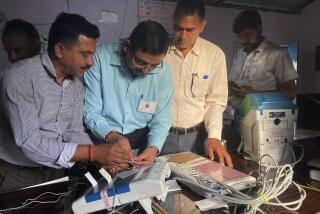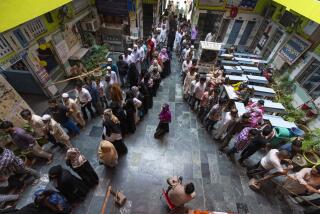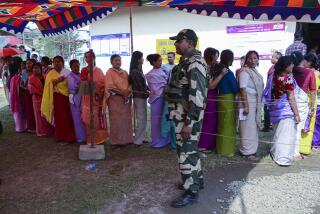Democracy Dawning in Nepal With Today’s Vote
- Share via
LAMOSANGU, Nepal — Old Bhindra Timulsina, whose battered and forgotten stone house is nestled in the foothills of Mt. Everest, was unsure just what to make of the dawning of democracy at the top of the world.
So far, the prelude to today’s voting has meant only trouble for him, his family and for most of the sleepy valley surrounding his little Himalayan hamlet, a village so remote it is just a day’s trek from Tibet.
The death toll remains in single digits, so far. But the violence here in recent days as Nepal’s first free election campaign in more than 30 years swept into town has been as unimaginable to the locals as the concept of democracy itself.
The tumult began about 10 days ago, when campaign workers from Nepal’s two most powerful political parties--the moderate Nepali Congress Party and the firebrand Nationalist Communist Alliance--joined forces to attack a wealthy, royalist candidate, a man closely linked to the ancestral monarchy that had ruled Nepal with an iron grip until the magical events of last year.
For 11 hours, they went at it in Lamosangu with stones, knives, clubs and iron bars, leaving scores injured and Bhindra Timulsina’s house, which he had rented to the royalists as a local headquarters, a badly scarred, isolated symbol of the “people’s enemy.”
“I haven’t left this place since that day,” the aged man shouted from his second-floor window last week to a rare visitor. “My son fled to Katmandu. The villagers said they’d kill him if they caught him. Democracy? No, we don’t know much about democracy up here yet.”
Nor has the lesson been a pleasant one in Sanu Pakar, the tiny neighboring village where the final attack of the campaign erupted last Sunday night in a melee that no one in the valley will soon forget. Everyone had knives that night, and before it was over, the hands of several partisans were chopped off.
And yet, painful as the arrival of democracy may be, it is virtually impossible to find anyone in this once-isolated Himalayan kingdom who is anything but delighted and relieved by the historic event that will unfold here today.
Nepal’s 11 million voters will trek to the polls--some in mountaintop villages so remote that their ballots must be carried by yaks or helicopters. With today’s voting, Nepal will complete a yearlong democratization that began with one of the world’s purest, most dramatic people-power revolts.
For several weeks a year ago, Nepali doctors, lawyers, students, teachers, house sweepers and corner vendors took to Katmandu’s streets, braving police bullets, tear gas, arrest and torture until they pressured the last of Nepal’s long-ruling monarchs, King Birendra, to give up his absolute power and agree to a new democratic order--including a new constitution and the staging of Nepal’s first multi-party elections in more than three decades.
Insulating himself in Nepal’s new blueprint for a constitutional monarchy not unlike that of Britain, the king and his 30,000-strong national army have remained little more than interested spectators throughout Nepal’s transition to democracy. And throughout the recent, monthlong election campaign, they have consistently pledged loyalty to the new democratic way.
The election has drawn scores of official international observers, teams sent here from the United States, Europe and the Third World to monitor the polls. Nepal’s bureaucracy has taken unprecedented security precautions, fielding the entire 35,000-member police force and hundreds of army “strike teams” throughout the nation to keep order on election day.
In speeches Thursday at a human rights forum in the capital, Nepal’s election commissioner and a senior bureaucrat in the Interior Ministry both promised that the elections will be as free and fair as possible. They noted that police and skilled observers have been posted at all 13,707 polling places, and an army of 66,000 government election workers has been deployed to deliver the latest in election paraphernalia--some having left the capital days ago to climb the world’s highest mountains in time for voting day.
“In a country like Nepal, where the majority of people are illiterate and poor and where the geography works against us, it is a difficult task to hold free and fair elections,” said Election Commissioner Surya Prasad Shrestha. “But we are trying to conduct this election in an efficient way. This is, after all, the laying of the foundation stone for our democracy and for our nation.”
Even the hardest-core Communists and human rights workers who formed the backbone of last year’s pro-democracy revolt concede that the Nepali bureaucracy has, indeed, made the best preparations possible for the election.
“Something happens here and there, and, yes, some people will be killed, but after 30 years in the darkness, we are hardly a mature democracy,” said Lok Raj Baral, a political science professor at Katmandu’s Tribhuvan University and veteran of the pro-democracy crusade. “After all, a poor, Third World country, suppressed for 30 years, naturally explodes on the streets with all the accompanying enthusiasm and expectations of this campaign. It is unprecedented . . . and some chaos, I am afraid, is unavoidable.”
The capital and its rugged, surrounding countryside, sandwiched between China and India, have been awash for weeks with the brilliant colors and artwork of the 21 political parties vying for 205 seats in the new House of Representatives.
That body will meet in a century-old palace, where laborers have worked frantically to prepare for democracy. They have been installing new seats and a sound system, all under the watchful eyes of the intricately carved Hindu gods on the ceiling of the hall, in which the king’s huge throne is a prominent reminder that he will remain Nepal’s symbolic figurehead.
On the streets outside the Parliament grounds, the intensity of the election fever is also apparent. It covers almost every inch of every building. Temples, lampposts and police kiosks have been emblazoned with curious drawings such as bushy green trees, blazing red suns and ancient plows. Most Nepalis are illiterate, so political parties rely on their official symbols--such as a plow, a rooster, a garden spade, and, of course, a sickle--to sway voters.
Of three main national forces vying for a majority, the alliance of vintage Marxists and Marxist-Leninists has made the most impressive showing, turning Katmandu’s downtown open-air theater into a sea of red for its final campaign rally Thursday night.
Despite the Communists’ strong appeal at the rural grass roots, where feudal landlords still rule, and among the urban poor, who are among the world’s most impoverished people, most analysts say the Nepali Congress Party will probably emerge with the largest number of seats in the National Assembly.
A collection of veteran moderates who ran the country during its last, brief democratic experiment (which ended when the king’s late father dissolved Parliament in 1960), the Congress Party has presided for the last year over an interim government, which included a handful of Communists.
Congress Party leaders have leveled their harshest campaign attacks against those same Communists; most analysts here speculate that if the Congress Party fails to secure a majority today, a result that many expect, it may be forced to form a ruling coalition with the country’s third political force, made up of holdovers from a party-less Parliament that was little more than a rubber stamp for the monarchy.
Pashupati Shamsher Rana--grandson of the last of the “Rana” prime ministers who ruled the nation for more than a century as political agents for the Nepalese kings--has emerged as the former royalists’ most articulate spokesman. His remote northern district includes Lamosangu, site of the campaign’s worst violence. In an interview, Pashupati condemned the election in advance, saying it is “totally biased. . . . It’s a reign of terror organized by the parties in power. . . . They won’t even let us campaign. There is no change between our system and theirs.”
But Pashupati, who is related to Nepal’s queen and acted as a key go-between in negotiations with the opposition that led to the king’s capitulation last year, said the elections will mark the end of Nepal’s long monarchal rule. “The king cannot come back now. The king is finished . . . because he has made such grave errors. He made the same mistakes as Napoleon and Hitler. He tried to fight on two fronts at once and lost on both.
“Certainly, this election is a return to democracy, but you must look at it in a different light. . . . These parties that have been in power for the past year have no respect for human rights. They’re just as corrupt as it was before. I’m just very disappointed.”
Ironically, Pashupati echoed many of his most bitter enemies, the many human rights activists who had spent years in jail before they led last year’s pro-democracy movement.
And it was for that reason that Nepal’s largest human rights group, led by veteran activist Rishikesh Shaha, sent workers across the country to assess the campaign, then organized a forum Thursday to air their findings and discuss the likelihood of free, fair elections.
One after another, the activists took the microphone to report outrages they had witnessed.
In a remote western district called Myagdi, a convicted murderer who had served just a quarter of his 20-year prison term for shooting a newspaper editor in the head five years ago, has organized gangs to fight for the local royalist candidate, one activist reported. In another northern district, another activist said that an extremist, Communist group--which is boycotting the election--is using sound trucks to warn that its workers will slice off the fingers of anyone who tries to “place their thumb print on a ballot paper.”
“There is this extensive criminalization of the political system, and it is very worrying,” Shaha said. “All sides are using criminals to disturb meetings. There is talk they will use them to capture booths on election day, and there is a free flow of money both from within Nepal and from outside.”
The issues have been blurred--subjects such as whether Nepal should remain an official Hindu state, whether its economy should be partially nationalized, whether rampant corruption now endemic in a nation that relies so heavily on foreign aid can ever be eliminated. And the violence itself has become a key issue, along with personalities.
Still, committed observers such as Shaha, who is not contesting the election, concede that, like elderly Bhindra Timulsina in Lamosangu, most Nepalis have no idea just what democracy is yet, nor have they seen enough of its positive results to respect it.
Man Bahadur Bhandari, 26, a university student working for the Communist alliance in its stronghold--the Katmandu suburb of Bhaktapur--may have said it best when asked last week whether Nepal’s poor, illiterate masses are ready for this election.
“No, they don’t know what is democracy yet,” he said. “When the democracy came, the illiterate people thought it was a good thing. They thought they would find all the food and clothes they need. But when it came, they got none of these things. And so now they think the democracy is no different from the palace system.
“And that is why elections are so important. They are the starting place, not the finishing place. . . . Only through elections will they begin to learn the meaning of a vote. And we hope this meaning will translate into a real change for Nepal.
“If not, democracy will remain just a word here in Nepal.”
NEPAL: PATH TO DEMOCRACY
HISTORY
After death of King Mahendra in 1972, Prince Birendra, then 26, ascended to throne of nation that shares Mt. Everest with Tibet. In 1980 referendum, voters rejected reintroduction of party system tried briefly two decades earlier, allowing continued autocratic rule by now King Birendra with advice of party-less National Assembly. The king permitted election of new legislature in May, 1986, to which prime minister and Cabinet are responsible. In 1990, pro-democracy movement forced king to lift ban on political parties and appoint an opposition leader as prime minister, heading an interim government that promised multi-party election within a year.
AT A GLANCE
Area: 54,463 square miles (about the size of Arkansas)
Pop.: 19.1 million
Density per square mile: 344
Monetary unit: Nepalese rupee
Languages: Nepali, Newari, Bhutia, Maithali
Religions: Hindu (90%), Buddhist (5%), Islam (3%)
Products: Rice, maize, wheat, millet, jute, sugar cane, oil seed, potatoes, sugar, lumber, cigarettes, cement and textiles.
More to Read
Sign up for Essential California
The most important California stories and recommendations in your inbox every morning.
You may occasionally receive promotional content from the Los Angeles Times.










